|
 Gliophorus lilacinoides Gliophorus lilacinoides
SynonymsHygrocybe lilacinoides
BiostatusPresent in region - Indigenous. Endemic
Images (click to enlarge)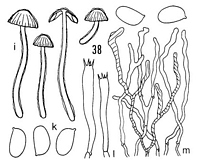
Caption: Gliophorus lilacinoides Hk. (type): i. carpophores. - k. spores. - 1. basidia. - m. cuticle | 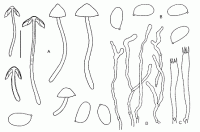
Caption: Fig. 38 Gliophorus lilacinoides Horak (A-D: PDD 27094, type):
A. basidiomes. B. spores. C. basidia. D. terminal cells of pileipellis hyphae. | 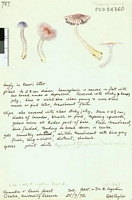
Caption: Watercolour
Owner: G.M. Taylor | 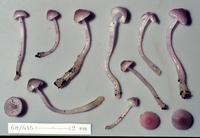
Caption: ZT68-646 , Holotype
Owner: E. Horak: © Creative Commons Attribution-Noncommercial 3.0 New Zealand | 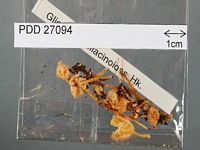
Caption: Dried type specimen
Owner: Herb PDD | 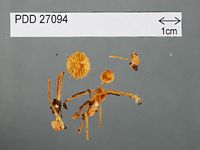
Caption: Dried type specimen
Owner: Herb PDD |
Article: Horak, E. (1990). Monograph of the New Zealand Hygrophoraceae (Agaricales). New Zealand Journal of Botany 28(3): 255-306 (http://www.rsnz.org/publish/abstracts.php).
Description: Pileus -20 mm, hemispherical later convex to campanulate, never expanded or
concave; lilac to wine red or reddish brown, paler towards striate margin, fading
to grey with age; glutinous, glabrous, hygrophanous. - Lamellae 10-14 (1-3)
subdistant, adnexed to emarginate-adnexed, not decurrent; brown with red tinge
when young, changing to pink-lilac finally fading to whitish in age, edges entire,
concolorous, glutinous thread absent. - Stipe 15~0 x 1.5-3 mm, cylindrical,
equal or attenuated towards apex; concolorous with pileus becoming ochre yellow
near and at base; glutinous, fistulose, single. - Context red-brown beneath
cuticle of pileus, pink in stipe. - Odour and taste not distinctive. - Chemical
reactions on pileus: KOH - negative.
Spores 7 - 8.5 x 4 4.5 um, ellipsoid. - Basidia 38-47 x 47 um, 4-spored. -
Cystidia absent. - Pileipellis an ixocutis of erect, cylindrical hyphae (2-6
um diam.), terminal cells slender fusoid to subclavate, often branched at tips,
hyaline membrane strongly gelatinised, plasmatic pigment; clamp connections
present (Pl. 1, Fig. 6).
Habitat: ECOLOGY: Scattered; saprobic on soil among litter or on rotten wood of Nothofagus
(fusca) or broadleaved conifer forest (Elaeocarpus, Knightia, Podocarpus,
Cyathea). March-July.
Distribution: DISTRIBUTION: NZ (SA, WL).
Notes: Gliophorus lilacinoides (and the closely related G. ostrinus)
are characterised by purple or lilac basidiomes. On the pileus this conspicuous
colour can fade with age and then it is often replaced by reddish brown tints
in the former and pink colours in the latter species. Purplish colours, however,
remain usually on the surface or in the context at the apex of the stipe. Similar
colour patterns are also reported for G. lilacipes (Horak). However,
this taxon is, apart from spore size, readily separated by having decurrent
lamellae and a morphologically different structure of the ixocutis on the pileus.
Article: Horak, E. (1973). Fungi Agaricini Novazelandiae I-V. Beihefte zur Nova Hedwigia 43: 200 p.
Description: Pileus 10-20 mm diam., hemispherical when young becoming convex to campanulate, never flat or concave, lilac to wine red or reddish-brown, paler towards the striated margin, fading to grey, glutinous, glabrous. Lamellae adnexed or emarginate-adnexed, not decurrent, reddish-brown, pink or lilac when young fading to whitish, moderately distant, gill edge concolorous, even. Stipe 15-60 x 1.5-3 mm, cylindric, equal or attenuated towards the apex, above concolorous with pileus, becoming ochraceous-yellow near the base, glutinous, fistulose, single. Context red-brown beneath the cuticle, pink in the stipe. Taste and odor not distinctive. Chemical reactions on pileus: KOH - negative.
Spores 7-8.5 x 4-4.5 µm, ellipsoid, smooth, inamyloid. Basidia 38-47 x 6-7 µm, 4-spored. Cystidia lacking. Cuticle an ixotrichoderm consisting or erect, gelatinized, densely interwoven hyphae (2-6 µm diam.), terminal cells differentiated (cylindric or fusoid, frequently branched), plasmatic pigment present. Clamp connections numerous.
Habitat: In soil amongst litter or on rotten wood in forests of Nothofagus spp. and Podocarpus-Dacrydium (associated with Cyathea, Elaeocarpus, Knightia, etc.). New Zealand.
Notes: Considering the lilac colours only, G. lilacinoides Hk. is very similar to G. versicolor Hk. However, macroscopically both species are already separated by the different shape of the lamellae and presence or absence of a characteristic unpleasant odor. In this way the green tinted pair G. viridis- G. graminicolor can be compared with the above mentioned lilac coloured species.
|